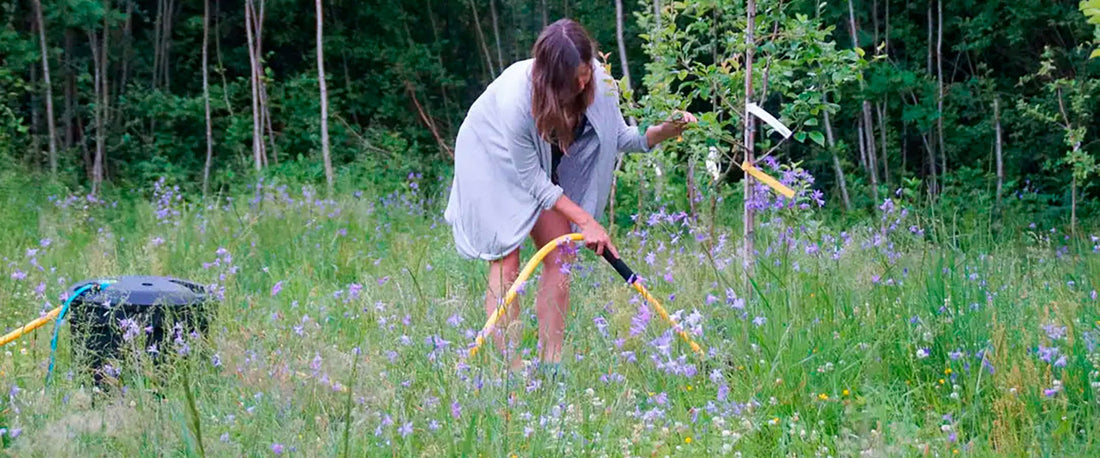
How to Build a Greywater & Urine Infiltration Pit – A Simple, Off-Grid Solution
Share
When using a urine-diverting toilet like the Separett Tiny or Villa, managing liquids responsibly is essential—especially in remote or off-grid locations where municipal sewage or a septic system is not available. One of the most effective and low-tech methods is an infiltration pit. This simple yet efficient solution allows urine and household greywater to safely percolate into the surrounding soil, providing a natural form of filtration.
In this guide, we’ll walk you through the materials, planning, and step-by-step construction of an infiltration pit tailored for 1–4 people.

📍 Choosing the Right Location
- Distance from water sources: The pit should be located at least 10 meters (33 feet) away from wells, springs, or any drinking water source.
- Natural slope: If possible, place the pit downhill from your toilet and greywater source to allow for gravity-fed flow.
- Soil type: Ideal soils are sandy or loamy, which allow for good drainage. Avoid heavy clay soils, low-lying areas, or locations prone to flooding.
📏 Dimensions for a Small Household
For a typical household of 1–4 people:
- Width: 60–90 cm (24–36 inches)
- Depth: 60–100 cm (24–39 inches)
If you expect higher use or year-round drainage in cold climates, consider building larger or multiple pits and rotating their use seasonally.
🧱 Materials You’ll Need
-
Coarse gravel or crushed stone
Size: 15–40 mm (⅝–1½ inches)
Use clean, angular stones—not smooth river pebbles or pea gravel -
Coarse sand (essential)
Size: 1–4 mm (about 1/16–3/16 inch)
Must be free of clay, silt, or fine particles -
Non-perforated pipe
To connect your toilet’s urine output and any greywater to the pit -
Landscape fabric (optional)
Helps prevent surrounding soil from clogging the filter layers -
Covering material
Treated wood, stone slab, or plastic lid for a secure and discreet finish
 The picture is not in correct proportions.
The picture is not in correct proportions.
🛠️ Step-by-Step Construction
-
Dig the Pit
Excavate a circular hole with slightly sloped sides to prevent collapse. Recommended dimensions: 60–90 cm wide and 60–100 cm deep. -
Line with Landscape Fabric (Optional)
If using, apply landscape fabric to the walls of the pit to minimize soil intrusion into the gravel and sand. -
Add the Gravel Layer
Fill the bottom 30–40 cm (12–16 inches) with coarse gravel. This base layer supports drainage and protects the pipe inlet from clogging. -
Add the Sand Layer
On top of the gravel, add 30–40 cm (12–16 inches) of coarse sand. This upper filter removes nutrients and particles from the urine and greywater.
Optional: Add a permeable fabric layer between gravel and sand—but only if it allows water to pass freely. -
Install the Inlet Pipe
Route a non-perforated pipe from your Separett toilet’s urine line or greywater outlet. The pipe should end 5–10 cm into the sand layer. -
Backfill and Cover
Backfill the remaining space above the pipe with more gravel, then cover with a breathable but secure lid—wood, stone, or metal all work well. A top layer of mulch or straw can help with odor and visual integration.
🔧 Maintenance and Care
- Annual inspection is recommended. If liquids are pooling or draining slowly, consider redirecting flow to a new pit.
- Avoid harsh chemicals or non-biodegradable soaps—they can harm soil microbes and clog the system.
- In cold climates, make sure the pit is deep enough to prevent freeze-ups in winter months.
🌱 Why It Matters
Combining a Separett waterless toilet with a greywater and urine infiltration pit is a simple yet powerful way to live more sustainably. It reduces strain on septic systems, protects natural water sources, and supports eco-conscious lifestyles—all without compromising on sanitation.
Have questions or need guidance for your specific installation? Feel free to reach out to our team at contact.us@separett.com.
